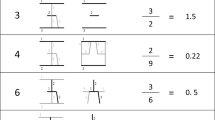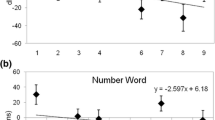Abstract
In this study, we evaluated whether the processing of two-digit Arabic numbers is subject to cognitive control. Participants performed a number comparison task with unit–decade compatible trials (36–47) and unit–decade incompatible number pairs (37–46). The unit–decade compatibility (incompatible minus compatible trials) was considered an index of conflict situation in numerical processing. To examine whether participants adapted to numerical conflict, we manipulated the percentage of incompatible trials relative to the percentage of compatible trials (20, 50, 80 % incompatible trials). The unit–decade compatibility effect was modulated by the amount of incompatible trials: the compatibility effect decreased progressively as the percentage of incompatible trials increased. This result indicated that participants adapted to numerical conflict. The findings are discussed in terms of cognitive control. Implications for models of two-digit number processing are also addressed.


Similar content being viewed by others
Notes
To control for between-subject differences in overall RT, we performed additional latency analyses with z scores computed for each participant individually. The results obtained with these data were the same as those reported with raw RT data. The Compatibility × Percentage of incompatibility interaction was significant, F(2, 93) = 4.19, p < 0.05, \( \eta_{\text{p}}^{2} \) = 0.08. The difference between compatible and incompatible trials was reduced in the 80 % incompatible condition relative to the 20 % incompatible condition t(62) = 2.57, p < 0.05.
We thank Matthew Crump for suggesting the possible dissociation between local versus global cognitive control.
References
Brysbaert, M. (1995). Arabic number reading: On the nature of the numerical scale and the origin of phonological recoding. Journal of Experimental Psychology: General, 124, 434–452.
Crump, M. J. C., Gong, Z., & Milliken, B. (2006). The context-specific proportion congruent effect: Location as a contextual cue. Psychonomic Bulletin & Review, 13, 316–321.
Ganor-Stern, D., Pinhas, M., & Tzelgov, J. (2009). Comparing two-digit numbers: The importance of being presented together. Quarterly Journal of Experimental Psychology, 62, 444–452. doi:10.1080/17470210802391631.
Ganor-Stern, D., Tzelgov, J., & Ellenbogen, R. (2007). Automaticity and two-digit numbers. Journal of Experimental Psychology: Human Perception and Performance, 33, 483–496.
Gratton, G., Coles, M. G. H., & Donchin, E. (1992). Optimizing the use of information: Strategic control of activation of responses. Journal of Experimental Psychology: General, 121, 480–506.
Jacoby, L. L., Lindsay, D. S., & Hessels, S. (2003). Item-specific control of automatic processes: Stroop process dissociations. Psychonomic Bulletin & Review, 10, 638–644.
Macizo, P., & Herrera, A. (2008). The effect of number codes in the comparison task of two-digit numbers. Psicológica, 29, 1–34.
Macizo, P., & Herrera, A. (2011). Cognitive control in number processing: Evidence from the unit–decade compatibility effect. Acta Psychologica, 136, 112–118. doi:10.1016/j.actpsy.2010.10.008.
Moeller, K., Fisher, M. H., Nuerk, H. C., & Willmes, K. (2009a). Sequential or parallel decomposed processing of two-digit numbers? Evidence from eye-tracking. Quarterly Journal of Experimental Psychology, 62, 323–334.
Moeller, K., Huber, S., Nuerk, H. C., & Willmes, K. (2011). Two-digit number processing: holistic, decomposed or hybrid? A computational modelling approach. Psychological Research, 75, 290–306. doi:10.1007/s00426-010-0307-2.
Moeller, K., Nuerk, H. C., & Willmes, K. (2009b). Internal number magnitude representation is not holistic, either. European Journal of Cognitive Psychology, 21, 672–685.
Moyer, R. S., & Landauer, T. K. (1967). Time required for judgements of numerical inequality. Nature, 215, 1519–1520.
Notebaert, W., & Verguts, T. (2008). Cognitive control acts locally. Cognition, 106, 1071–1080. doi:10.1016/j.cognition.2007.04.011.
Nuerk, H. C., Weger, U., & Willmes, K. (2001). Decade breaks in the mental number line? Putting the tens and units back in different bins. Cognition, 82, B25–B33. doi:10.1016/S0010-0277(01)00142-1.
Nuerk, H. C., Weger, U., & Willmes, K. (2004). On the perceptual generality of the unit–decade compatibility effect. Experimental Psychology, 51, 72–79. doi:10.1027/1618-3169.51.1.72.
Nuerk, H. C., & Willmes, K. (2005). On the magnitude representations of two-digit numbers. Psychological Science, 47, 52–72.
Posner, M. I., & Snyder, C. R. R. (1975). Attention and cognitive control. In R. L. Solso (Ed.), Information processing and cognition: The Loyola symposium (pp. 55–85). Hillsdale: Erlbaum.
Schneider, W., Eschman, A., & Zuccolotto, A. (2002). E-Prime user’s guide (Version 1.1). Pittsburg: Psychology Software Tools.
Tzelgov, J., Henik, A., & Berger, J. (1992). Controlling Stroop effects by manipulating expectations for color words. Memory & Cognition, 20, 727–735. doi:10.3758/BF03202722.
Verguts, T., & Notebaert, W. (2008). Hebbian learning of cognitive control: Dealing with specific and nonspecific adaptation. Psychological Review, 115, 518–525. doi:10.1037/0033-295X.115.2.51.
Verguts, T., & Notebaert, W. (2009). Adaptation by binding: A learning account of cognitive control. Trends in Cognitive Science, 13, 252–257. doi:10.1016/j.tics.2009.02.007.
Verguts, T., Notebaert, W., Kunde, W., & Wühr, P. (2011). Post-conflict slowing: Cognitive adaptation after conflict processing. Psychonomic Bulletin & Review, 18, 76–82. doi:10.3758/s13423-010-0016-2.
Acknowledgments
This study was supported by the Spanish Ministry of Education and Science (research project PSI2009-11094) and by the Programa de Generación de Conocimiento Científico de Excelencia de la Fundación Séneca, Agencia de Ciencia y Tecnología de la Región de Murcia (research project 08741/PHCS/08). We would like to thank Ana María Flores and Verónica Juárez for running participants. Also, we are grateful to Klaus Willmes for comments on data reported in this work.
Author information
Authors and Affiliations
Corresponding author
Rights and permissions
About this article
Cite this article
Macizo, P., Herrera, A. The processing of Arabic numbers is under cognitive control. Psychological Research 77, 651–658 (2013). https://doi.org/10.1007/s00426-012-0456-6
Received:
Accepted:
Published:
Issue Date:
DOI: https://doi.org/10.1007/s00426-012-0456-6




